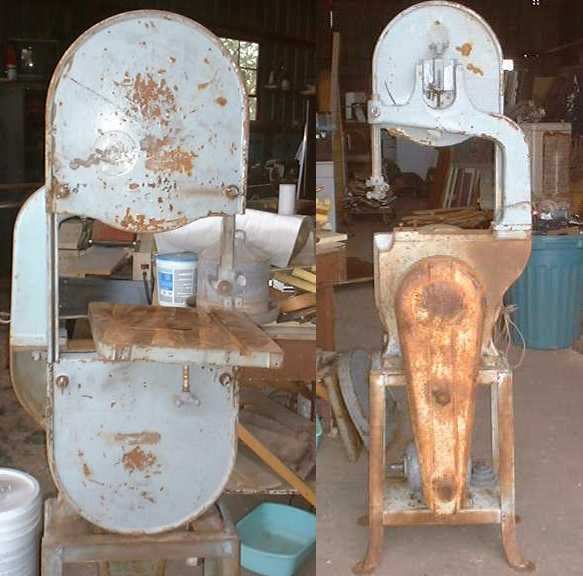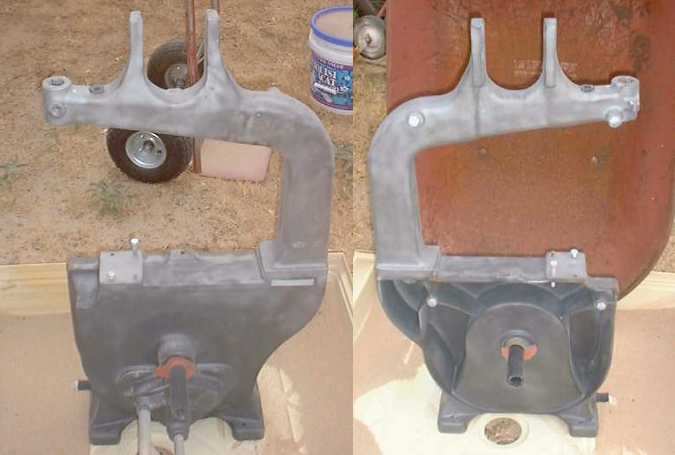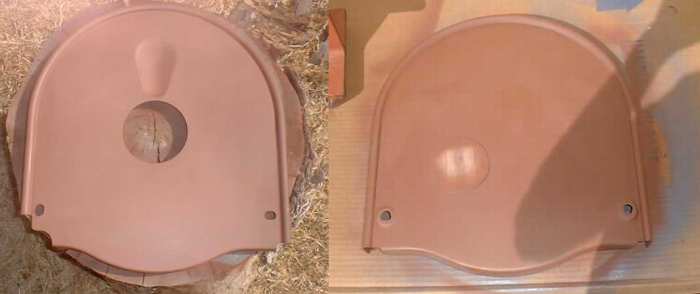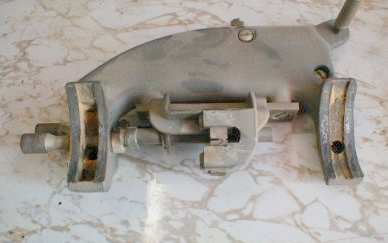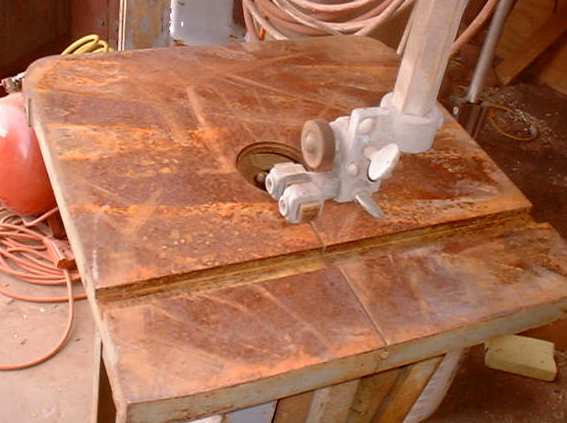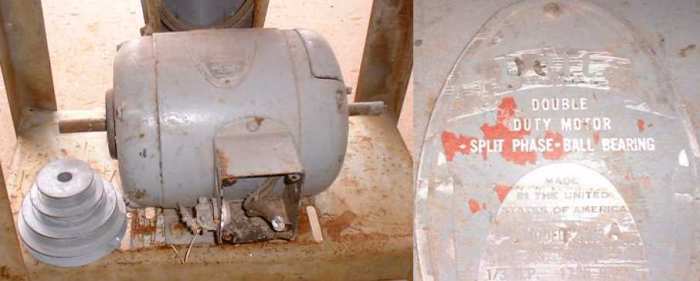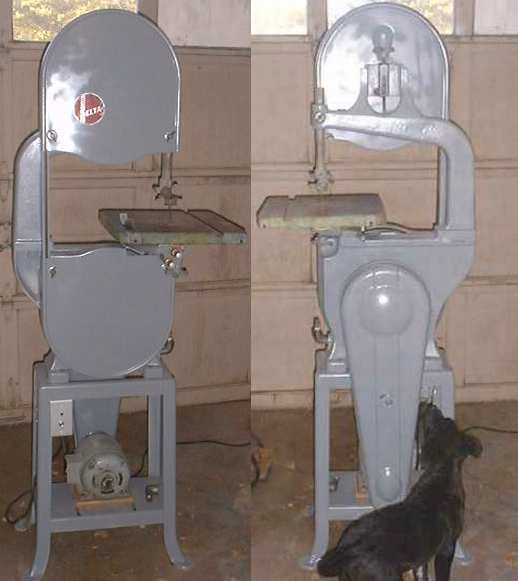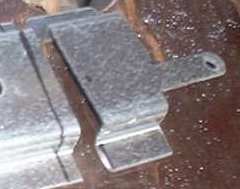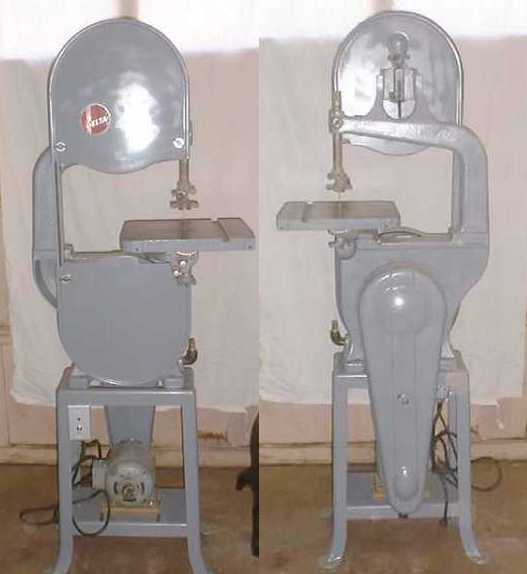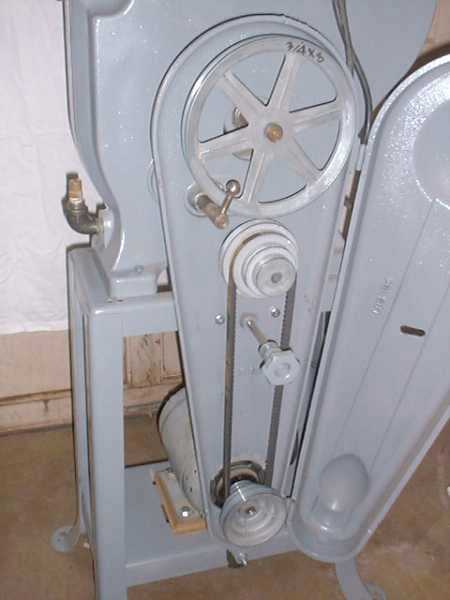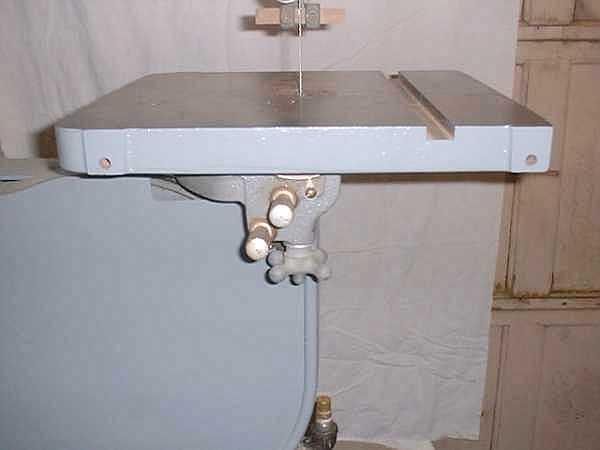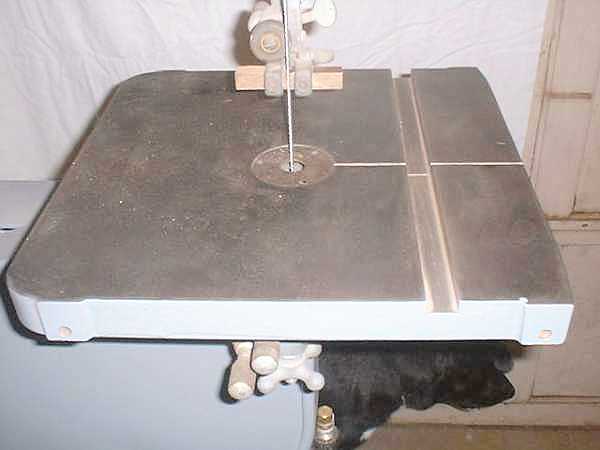SadOldSaw1945 Delta # 890 Wood/Metal Bandsaw As found sometime in August 2003.
So you can see, the poor old thing needed a thorough going over but it was pretty complete, lacking mainly the table support bracket with lower blade guides. After I did a little research I became more & more enthused with my find and set about discovering the original castings underneath all that grime & rust. Here is the serial number for those of you who like to verify things:
The left-hand photo shows the gearbox that separates this model from most bandsaws; when you run the drive belt to the lower input shaft via step pulleys you get an adjustable speed metal cutting saw; using the upper input shaft provides the proper speed for woodwork. The third shaft (middle and to the left) is the gearshift; it selects which input is active.
I also cleaned up the sheet metal covers, the cast iron belt guard & other major components except the table with the sandblaster. The wheel covers were in the worst shape so I gave them a coat of aluminum oxide red primer then started applying the gray. I had plugged all bolt holes & the ways for the tension adjuster on the upper wheel assembly. You can see I taped off the logo plate to avoid gobbing any more paint on it. I can't imagine why someone had painted it gray.
By this time I had bought & received shipment of the missing table support complete with the table stop.
And I had also bought a second incomplete (1950 model) from new friend Glenn. So far I have not cleaned up the table that came with mine; I just mounted the Glennsaw table & bracket assembly for use while I decide what to do with the really rusty one which I intend to save & use if possible just to keep it as original as possible. Original table:
There are some pretty bad pits underneath that rust so I might have to have it milled. When I got the upper cover cleaned up I started cleaning the logo plate and was amazed to find a little bit of the original color. Removing the gray also was removing the red so I decided to stop while there was something left.
This little 1/3 hp motor came with the sadoldsaw. I have replaced the bearings but have done nothing to the finish so far. Its a fine little motor & a keeper but I doubt its going to suffice for the long haul.
Of course there were many other little problems to iron out such as the hole spacing of the belt guard not lining up with the holes in the base. I had to weld up a little bracket with a bolt pointing front & back then cut rubber spacers from on old mud flap to space the guard from the saw to make the pully alignment work out. Had to glue the upper blade guard back together, numerous things like that. So here is what I have so far, modeled by new shop assistant Jake:
Above shows the table from the 1950 model saw, looks kinda ugly but works just fine. There are still lots of little details to work through, like a dust chute of some kind, stronger motor, new table inserts & maybe build a mobile base for it. The upper blade guide assemby needs cleaning, maybe painted - yada yada yada. You can take this kind of thing about as far as you want to. I am about ready to take a break. Here is one reason I am so pleased to have this machine - cuts like these:
Cuts like that skinny leftover little finger on the left or that rounded tab on the right hand picture are impossible on my horizontal band saw. (This begins the update of work done since the original post of the project. I used a slightly different font for clarity.) The old saw has sat in my garage ever since I posted the pictures and text above this point since last Novemeber 16th. I did indeed run the original table through the electrolysis bucket and removed the worst of the rust, sanded it down a bit and painted the underside & edges. Then the table wound up stored under a footstool in my living room for several months, neglected but not forgotten. I really didn't need it to use the saw so, you know - priorities, casualties of war, all that. Finally I got it out, dusted it off and swapped out the tables. That green one was pretty ugly & I realized that much more clearly once I bolted the new one on.
I never did get around to showing the pulley and gearbox system that makes this saw useful for metal fabrication in the first go-round. Here is the backview where you can see it set up for slow speed.
The upper 8 inch pulley is mounted on a shaft that goes straight through to run the drive wheel at woodworking speeds. The top step pulley runs through the gear box for slow speeds suitable for metal cutting. The little handle between the 2 pulleys is the "gearshift" and chooses between straight drive or the gearbox. The pulley on the motor shaft is unfortunately a poor substitute for the original because it will only mount "inside-out" and will not allow the door to close without rubbing on the guard. I may wind up sawing the largest stage off of it to make in work more like it should. Delta wants more than I can consent to pay for an original & I can't seem to locate one anywhere else. Oh well, fortunes of war, as the elephant said. It works. That was the point, after all. As to the original table, here is how it came out after de-rusting and paint:
Grey just does look better than green, don't you think? Yeah, I know the bracket doesn't exactly match the freshly painted parts, but I just have limits on my attention span & I am restoring it to use, not to sit on display somewhere. The surface didn't come out completely clean, either but it is plenty good enough for my purposes & much better than when I found it. Here is a shot of it:
The picture makes it look a little worse than it really is, I think. And I had a new bi-metal blade made for it a short time ago, cuts really clean and fast. Here is a cut I just made for the cart I am working on.
Long skinny pictures like that give me fits so that is only about 2/3 of the actual piece. The total cut was about 18 inches long in 1/8th angle iron & I think it took maybe 5 minutes. So I can run at 3 - 5 inches per minute in that material I guess, without really crowding the blade. The neat thing is that I can now rip steel kinda like wood and cut most curves as well. So, all in all, I am very pleased to have this machine in my inventory. I have invested lots of time, maybe $400 in it and had a lot of fun sharing it with you. It is such a solid old thing compared to the new ones and well-deserving of the attention it has taken to restore her pride and utility. And there is no substitute for the satisfaction I get from using a tool I have saved from the scrap heap.
All in all it has been a fairly easy project to find the necessary parts to make it work; no single stage of it has been especially difficult - there were just lots of stages. But now that it is back in service it should be ready to work another 40 - 50 years. Try getting that kind of use out of your Harbor Freight tools. I would like to thank Stephen Rockwell and Glenn Williamson for their help & encouragement, and as always
|
